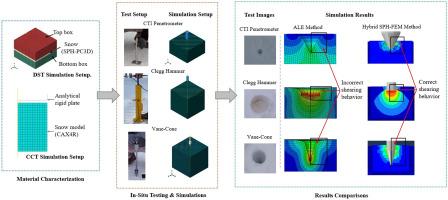采用CTI贯深仪、克莱格锤和叶片锥装置对压实雪的贯深试验进行数值模拟
IF 3.8
2区 工程技术
Q1 ENGINEERING, CIVIL
引用次数: 0
摘要
摘要数值模拟对于评估轮胎在雪地路面上的性能、提高安全性、牵引力和操控性至关重要。它们的准确性依赖于稳健的本构模型和能够捕捉雪的非线性行为的数值方法。许多研究依赖于传统的有限元方法和基于校准的参数识别,这限制了各种载荷下压实雪特性预测的准确性。本研究开发了一种系统的方法来识别和验证压实雪(500 kg/m3密度)的本构模型参数,使用实验室测试数据。直接剪切试验(DST)和受限压缩试验(CCT)的实验数据用于确定Drucker-Prager帽塑性材料模型参数,确保在剪切和压缩载荷下准确表示压实雪。然后,通过对DST和CCT的数值模拟,与实验数据进行对比,验证了材料模型的正确性。采用确定的积雪材料模型和任意拉格朗日-欧拉(ALE)、光滑颗粒流体力学(SPH)和SPH- fem混合方法对CTI穿透仪、Clegg锤和叶片锥装置进行了数值模拟。将仿真结果与现场试验数据进行对比,评价数值方法的精度、稳定性和计算效率。在未来,本研究中形成的理解可用于直接从原位穿透数据中识别雪材料参数,用于模拟法规测试(例如ASTM F1805),从而用于冬季轮胎模型的虚拟验证。本文章由计算机程序翻译,如有差异,请以英文原文为准。

Numerical simulations of compacted snow penetration tests using CTI penetrometer, Clegg hammer, and vane-cone device
Abstract
Numerical simulations are essential for assessing tire performance on snowy roads, enhancing safety, traction, and handling. Their accuracy depends on robust constitutive models and numerical methods capable of capturing snow's nonlinear behavior. Many studies rely on traditional FEM methods and calibration-based parameter identification, which limit the accuracy of compacted snow behavior predictions for various loadings. This study develops a systematic methodology for identifying and validating constitutive model parameters of compacted snow (500 kg/m3 density), using laboratory testing data. Experimental data from Direct Shear Tests (DST) and Confined Compression Tests (CCT) were used to determine Drucker-Prager Cap plasticity material model parameters, ensuring accurate representation of compacted snow under shear and compression loading. Then, the material model was verified through numerical simulations of DST and CCT by comparing the results with the experimental data. Simulations of the CTI penetrometer, Clegg hammer, and vane-cone device were also performed using the identified snow material model and different numerical methods including Arbitrary Lagrangian-Eulerian (ALE), Smoothed Particle Hydrodynamics (SPH), and hybrid SPH-FEM. The simulation results were compared to in-situ test data to evaluate the accuracy, stability, and computational efficiency of the numerical methods. In future, the understanding developed in this study could be used in the identification of snow material parameters directly from in-situ penetration data for simulation of regulatory tests (e.g. ASTM F1805) and consequently in virtual validation of winter tire models.
求助全文
通过发布文献求助,成功后即可免费获取论文全文。
去求助
来源期刊

Cold Regions Science and Technology
工程技术-地球科学综合
CiteScore
7.40
自引率
12.20%
发文量
209
审稿时长
4.9 months
期刊介绍:
Cold Regions Science and Technology is an international journal dealing with the science and technical problems of cold environments in both the polar regions and more temperate locations. It includes fundamental aspects of cryospheric sciences which have applications for cold regions problems as well as engineering topics which relate to the cryosphere.
Emphasis is given to applied science with broad coverage of the physical and mechanical aspects of ice (including glaciers and sea ice), snow and snow avalanches, ice-water systems, ice-bonded soils and permafrost.
Relevant aspects of Earth science, materials science, offshore and river ice engineering are also of primary interest. These include icing of ships and structures as well as trafficability in cold environments. Technological advances for cold regions in research, development, and engineering practice are relevant to the journal. Theoretical papers must include a detailed discussion of the potential application of the theory to address cold regions problems. The journal serves a wide range of specialists, providing a medium for interdisciplinary communication and a convenient source of reference.
 求助内容:
求助内容: 应助结果提醒方式:
应助结果提醒方式:


